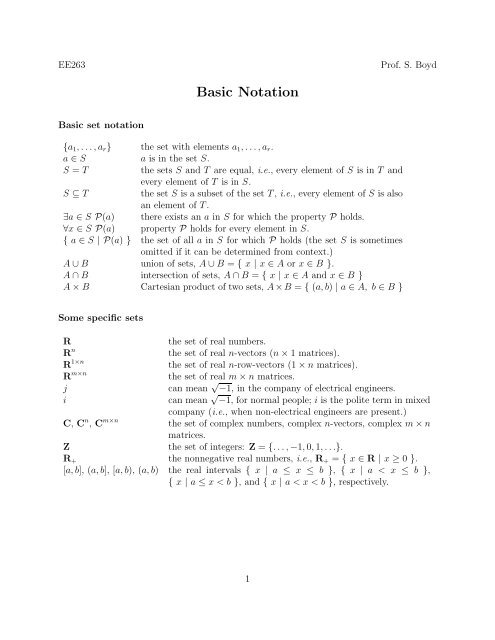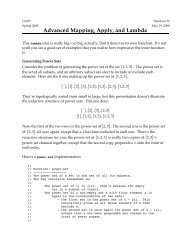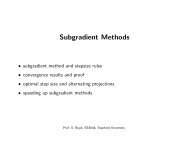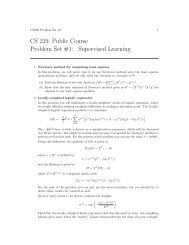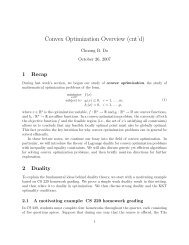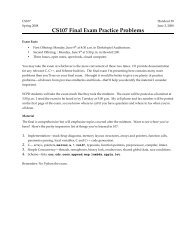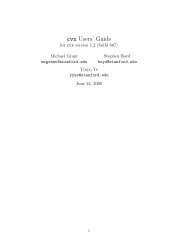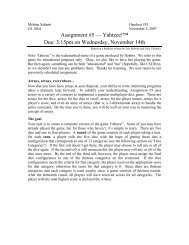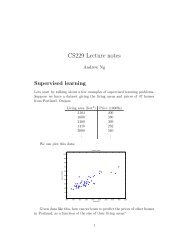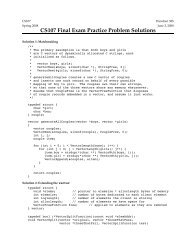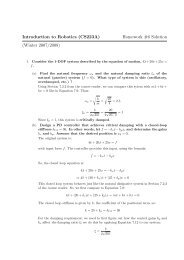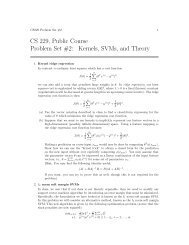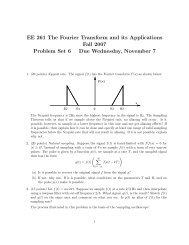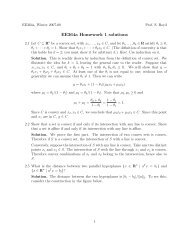Basic Notation - Stanford Engineering Everywhere
Basic Notation - Stanford Engineering Everywhere
Basic Notation - Stanford Engineering Everywhere
Create successful ePaper yourself
Turn your PDF publications into a flip-book with our unique Google optimized e-Paper software.
EE263Prof. S. Boyd<strong>Basic</strong> <strong>Notation</strong><strong>Basic</strong> set notation{a 1 , . . .,a r } the set with elements a 1 , . . .,a r .a ∈ S a is in the set S.S = T the sets S and T are equal, i.e., every element of S is in T andevery element of T is in S.S ⊆ T the set S is a subset of the set T, i.e., every element of S is alsoan element of T.∃a ∈ S P(a) there exists an a in S for which the property P holds.∀x ∈ S P(a) property P holds for every element in S.{ a ∈ S | P(a) } the set of all a in S for which P holds (the set S is sometimesomitted if it can be determined from context.)A ∪ B union of sets, A ∪ B = { x | x ∈ A or x ∈ B }.A ∩ B intersection of sets, A ∩ B = { x | x ∈ A and x ∈ B }A × B Cartesian product of two sets, A ×B = { (a, b) | a ∈ A, b ∈ B }Some specific setsRR nR 1×nR m×njithe set of real numbers.the set of real n-vectors (n × 1 matrices).the set of real n-row-vectors (1 × n matrices).the set of real m × n matrices.can mean √ −1, in the company of electrical engineers.can mean √ −1, for normal people; i is the polite term in mixedcompany (i.e., when non-electrical engineers are present.)C, C n , C m×n the set of complex numbers, complex n-vectors, complex m × nmatrices.Z the set of integers: Z = {. . .,−1, 0, 1, . . .}.R + the nonnegative real numbers, i.e., R + = { x ∈ R | x ≥ 0 }.[a, b], (a, b], [a, b), (a, b) the real intervals { x | a ≤ x ≤ b }, { x | a < x ≤ b },{ x | a ≤ x < b }, and { x | a < x < b }, respectively.1
Vectors and matricesWe use square brackets [ and ] to construct matrices and vectors, with white space delineatingthe entries in[ a row, and]a new line indicating a new row. For example [1 2] is a row vector1 2 3in R 1×2 , and is matrix in R 2×3 . [1 2]4 5 6T denotes a column vector, i.e., an elementof R 2×1 , which we abbreviate as R 2 .We use curved brackets ( and ) surrounding lists of entries, delineated by commas, as analternative method to construct (column) vectors. Thus, we have three ways to denote acolumn vector:[ ]1(1, 2) = [1 2] T = .2Note that in our notation scheme (which is fairly standard), [1, 2, 3] and (1 2 3) aren’t used.FunctionsThe notation f : A → B means that f is a function on the set A into the set B. Thenotation b = f(a) means b is the value of the function f at the point a, where a ∈ A andb ∈ B. The set A is called the domain of the function f; it can thought of as the set of legalparameter values that can be passed to the function f. The set B is called the codomain(or sometimes range) of the function f; it can thought of as a set that contains all possiblereturned values of the function f.There are several ways to think of a function. The formal definition is that f is a subsetof A × B, with the property that for every a ∈ A, there is exactly one b ∈ B such that(a, b) ∈ f. We denote this as b = f(a).Perhaps a better way to think of a function is as a black box or (software) function orsubroutine. The domain is the set of all legal values (or data types or structures) that can bepassed to f. The codomain of f gives the data type or data structure of the values returnedby f.Thus f(a) is meaningless if a ∉ A. If a ∈ A, then b = f(a) is an element of B. Also notethat the function is denoted f; it is wrong to say ‘the function f(a)’ (since f(a) is an elementof B, not a function). Having said that, we do sometimes use sloppy notation such as ‘thefunction f(t) = t 3 ’. To say this more clearly you could say ‘the function f : R → R definedby f(t) = t 3 for t ∈ R’.2
Examples• −0.1 ∈ R, √ 2 ∈ R + , 1 − 2j ∈ C (with j = √ −1).• The matrixA =[0.3 6.1 −0.127.2 0 0.01is an element in R 2×3 . We can define a function f : R 3 → R 2 as f(x) = Ax for anyx ∈ R 3 . If x ∈ R 3 , then f(x) is a particular vector in R 2 . We can say ‘the functionf is linear’. To say ‘the function f(x) is linear’ is technically wrong since f(x) is avector, not a function. Similarly we can’t say ‘A is linear’; it is just a matrix.• We can define a function f : {a ∈ R | a ≠ 0} × R n → R n by f(a, x) = (1/a)x, forany a ∈ R, a ≠ 0, and any x ∈ R n . The function f could be informally described asdivision of a vector by a nonzero scalar.• Consider the set A = { 0, −1, 3.2 }. The elements of A are 0, −1 and 3.2. Therefore,for example, −1 ∈ A and { 0, 3.2 } ⊆ A. Also, we can say that ∀x ∈ A, − 1 ≤ x ≤ 4or ∃x ∈ A, x > 3.• Suppose A = { 1, − 1 }. Another representation for A is A = { x ∈ R | x 2 = 1 }.• Suppose A = { 1, − 2, 0 } and B = { 3, − 2 }. ThenA ∪ B = { 1, − 2, 0, 3 }, A ∩ B = { − 2 }.• Suppose A = { 1, − 2, 0 } and B = {1, 3}. ThenA × B = { (1, 1), (1, 3), (−2, 1), (−2, 3), (0, 1), (0, 3) }.• f : R → R with f(x) = x 2 − x defines a function from R to R while u : R + → R 2with[ ]t costu(t) =2e −t .defines a function from R + to R 2 .]3


